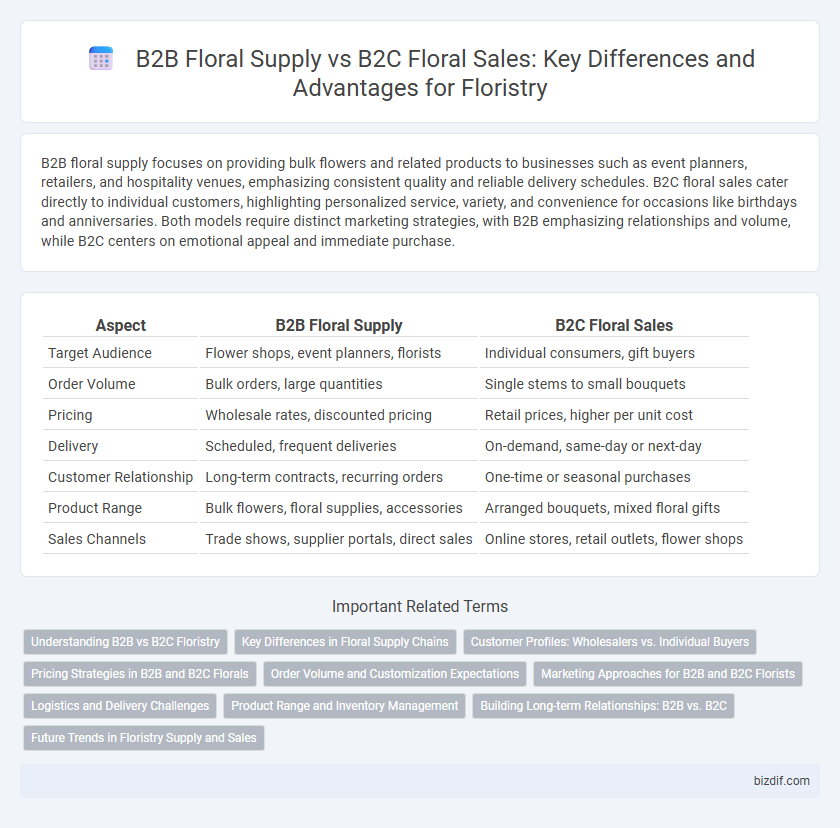B2B floral supply focuses on providing bulk flowers and related products to businesses such as event planners, retailers, and hospitality venues, emphasizing consistent quality and reliable delivery schedules. B2C floral sales cater directly to individual customers, highlighting personalized service, variety, and convenience for occasions like birthdays and anniversaries. Both models require distinct marketing strategies, with B2B emphasizing relationships and volume, while B2C centers on emotional appeal and immediate purchase.
Table of Comparison
| Aspect | B2B Floral Supply | B2C Floral Sales |
|---|---|---|
| Target Audience | Flower shops, event planners, florists | Individual consumers, gift buyers |
| Order Volume | Bulk orders, large quantities | Single stems to small bouquets |
| Pricing | Wholesale rates, discounted pricing | Retail prices, higher per unit cost |
| Delivery | Scheduled, frequent deliveries | On-demand, same-day or next-day |
| Customer Relationship | Long-term contracts, recurring orders | One-time or seasonal purchases |
| Product Range | Bulk flowers, floral supplies, accessories | Arranged bouquets, mixed floral gifts |
| Sales Channels | Trade shows, supplier portals, direct sales | Online stores, retail outlets, flower shops |
Understanding B2B vs B2C Floristry
B2B floral supply involves bulk transactions between growers, wholesalers, and florists, emphasizing consistent quality, competitive pricing, and reliable delivery schedules to support large-scale floral businesses. In contrast, B2C floral sales focus on individual customers seeking personalized arrangements, seasonal varieties, and immediate purchase options, often through retail shops or online stores. Understanding these distinct market demands helps florists optimize inventory management, marketing strategies, and customer service tailored to each segment's unique requirements.
Key Differences in Floral Supply Chains
B2B floral supply chains prioritize large-scale, consistent deliveries to retailers, event planners, and florists, emphasizing bulk purchasing, reliable sourcing, and long-term partnerships. B2C floral sales focus on personalized, smaller orders with fast delivery and customized arrangements directly to consumers. Inventory management in B2B relies on forecast accuracy and extended shelf life, while B2C must address immediate demand and seasonal trends with flexible stock.
Customer Profiles: Wholesalers vs. Individual Buyers
Wholesalers in the B2B floral supply market prioritize bulk orders, consistent quality, and reliable delivery schedules to serve florists, event planners, and retailers. Individual buyers in B2C floral sales focus on personalized service, variety in flower types, and convenience for occasions like weddings, anniversaries, or home decoration. Understanding these distinct customer profiles enables floral businesses to tailor pricing, packaging, and marketing strategies for maximum impact and customer satisfaction.
Pricing Strategies in B2B and B2C Florals
B2B floral supply pricing strategies emphasize volume discounts, contract rates, and wholesale pricing to secure long-term partnerships with florists and event planners, often involving negotiated prices based on order size and frequency. In contrast, B2C floral sales focus on retail pricing models that incorporate markups to cover costs such as packaging, delivery, and seasonal demand fluctuations, with dynamic pricing applied during holidays or special occasions. Both sectors leverage data analytics to optimize pricing elasticity, ensuring competitiveness while maximizing profit margins in the floral industry.
Order Volume and Customization Expectations
B2B floral supply typically involves large order volumes tailored for events, retailers, or corporate clients, demanding consistent quality and bulk pricing. B2C floral sales tend to emphasize smaller, personalized arrangements with a high degree of customization to meet individual customer preferences and occasions. Bulk sourcing in B2B requires streamlined logistics and inventory management, whereas B2C prioritizes unique designs and timely delivery for customer satisfaction.
Marketing Approaches for B2B and B2C Florists
B2B floral supply marketing leverages targeted strategies such as wholesale pricing, bulk order discounts, and relationship-driven outreach to attract event planners, retailers, and floral designers, emphasizing reliability and product variety. B2C floral sales focus on emotional appeal, utilizing social media campaigns, seasonal promotions, and personalized customer experiences to drive impulse buying and brand loyalty among individual consumers. Digital platforms for B2B often prioritize efficient ordering systems and detailed product information, while B2C marketing highlights aesthetic visuals and customer testimonials to enhance engagement.
Logistics and Delivery Challenges
B2B floral supply faces complex logistics challenges including bulk order management, maintaining flower freshness during large shipments, and coordinating scheduled deliveries to businesses such as event planners and retailers. In contrast, B2C floral sales demand efficient last-mile delivery solutions to individual customers, requiring precise timing and packaging to ensure product quality and customer satisfaction. Both sectors must invest in temperature-controlled transport and real-time tracking systems to optimize delivery accuracy and minimize spoilage.
Product Range and Inventory Management
B2B floral supply typically involves a broader product range including bulk fresh flowers, greenery, and floral supplies designed for professional florists, event planners, and retailers, which requires efficient inventory management systems to handle large volumes and diverse SKUs. In contrast, B2C floral sales focus on curated bouquets and ready-to-purchase arrangements with a narrower product range, prioritizing freshness and presentation over bulk inventory. Effective inventory management in B2C emphasizes rapid turnover and accurate forecasting to minimize waste and ensure product availability for immediate consumer demand.
Building Long-term Relationships: B2B vs. B2C
B2B floral supply emphasizes building long-term relationships through consistent quality, bulk discounts, and reliable delivery schedules tailored to businesses like event planners and retailers. In contrast, B2C floral sales focus on immediate customer satisfaction and emotional connections, often relying on personalized service and seasonal promotions. Cultivating trust and understanding client needs are crucial in B2B to maintain repeat orders, while B2C prioritizes engagement and experience to encourage loyalty.
Future Trends in Floristry Supply and Sales
Emerging technologies in floristry supply chains are streamlining B2B operations, enhancing inventory management through AI-driven forecasting and reducing waste in floral procurement. B2C floral sales are increasingly leveraging augmented reality for personalized bouquet customization and subscription models that boost customer retention. Sustainability remains a critical trend, with both B2B suppliers and B2C retailers prioritizing eco-friendly packaging and locally sourced, seasonal flowers.
B2B floral supply vs B2C floral sales Infographic

 bizdif.com
bizdif.com